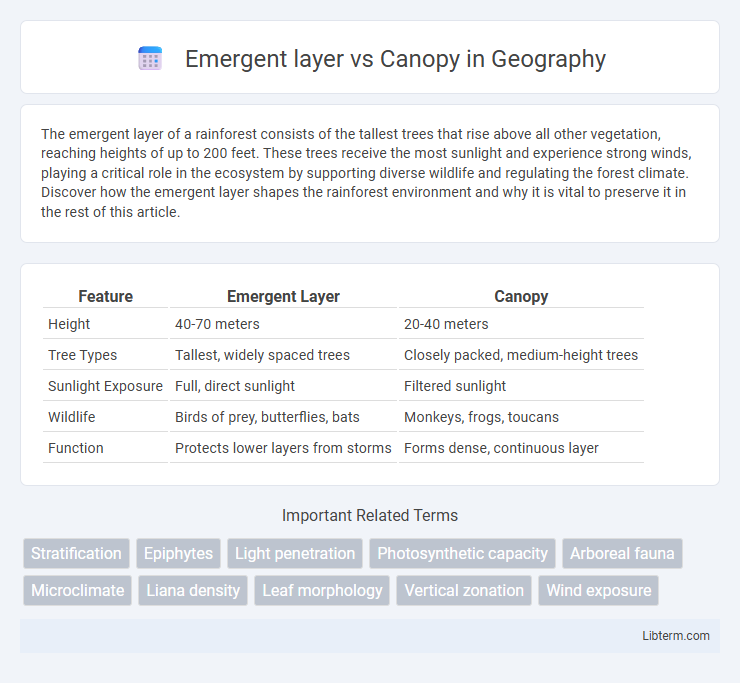The emergent layer of a rainforest consists of the tallest trees that rise above all other vegetation, reaching heights of up to 200 feet. These trees receive the most sunlight and experience strong winds, playing a critical role in the ecosystem by supporting diverse wildlife and regulating the forest climate. Discover how the emergent layer shapes the rainforest environment and why it is vital to preserve it in the rest of this article.
Table of Comparison
| Feature | Emergent Layer | Canopy |
|---|---|---|
| Height | 40-70 meters | 20-40 meters |
| Tree Types | Tallest, widely spaced trees | Closely packed, medium-height trees |
| Sunlight Exposure | Full, direct sunlight | Filtered sunlight |
| Wildlife | Birds of prey, butterflies, bats | Monkeys, frogs, toucans |
| Function | Protects lower layers from storms | Forms dense, continuous layer |
Introduction to Rainforest Layers
The emergent layer in a rainforest consists of the tallest trees, reaching heights of up to 60 meters, and receives the most sunlight, supporting diverse bird species and insects. Below it, the canopy forms a dense, continuous layer of trees approximately 20 to 45 meters high, creating a vital habitat that regulates temperature and moisture for the layers beneath. These two layers play crucial roles in maintaining rainforest biodiversity, with the emergent layer acting as a natural barrier to wind and the canopy enabling nutrient cycling and providing shelter for countless organisms.
What is the Emergent Layer?
The emergent layer is the tallest stratum in a rainforest, consisting of individual trees that rise above the dense canopy layer, reaching heights of up to 70 meters (230 feet). These towering trees receive maximum sunlight, experience strong winds, and host specialized wildlife like eagles, bats, and butterflies adapted to high-altitude conditions. Unlike the continuous canopy, the emergent layer is characterized by isolated giants that play a crucial role in regulating temperature and supporting biodiversity in tropical rainforests.
Key Characteristics of the Canopy Layer
The canopy layer, situated below the emergent layer, forms a dense and continuous ceiling of closely spaced tree crowns averaging 20 to 40 meters in height. It plays a crucial role in photosynthesis and habitat provision, supporting a rich biodiversity including numerous birds, insects, and mammals. This layer significantly influences forest microclimate by regulating temperature, humidity, and light penetration to the understory.
Height and Light Differences
The emergent layer consists of the tallest trees, reaching heights of up to 70 meters, that rise above the canopy to receive maximum sunlight exposure. The canopy layer, typically ranging from 20 to 40 meters tall, forms a dense, continuous roof that captures most of the light, creating a shaded environment beneath. Light intensity in the emergent layer can be up to 100% full sunlight, while the canopy experiences diffused light, with lower levels reaching the understory.
Flora Found in the Emergent Layer
The emergent layer of a rainforest is characterized by towering trees such as the kapok (Ceiba pentandra) and Brazil nut (Bertholletia excelsa) that rise above the canopy, receiving maximum sunlight. These flora species have adapted with thick trunks and small, waxy leaves to withstand intense sunlight and strong winds. Unlike the dense, shaded canopy below, the emergent layer supports flora that thrive in open, sunlit environments with minimal competition for light.
Fauna Unique to the Canopy
The canopy layer hosts a diverse array of fauna uniquely adapted to its dense foliage, including arboreal mammals like howler monkeys and sloths, numerous bird species such as toucans and parrots, and a variety of insects specialized for leaf-dwelling. Unlike the emergent layer, home to soaring raptors and bats adapted for open flight, canopy fauna engage in complex ecological roles involving pollination, seed dispersal, and predator-prey interactions within a multi-layered habitat. This biodiversity-rich zone supports intricate food webs sustained by its abundance of fruits, flowers, and microhabitats unavailable in the more exposed emergent layer.
Climate and Microenvironment Variations
The emergent layer experiences higher wind speeds, increased temperature fluctuations, and greater solar radiation compared to the more stable and shaded microenvironment of the canopy. These variations create distinct microclimates that influence species adaptation and biodiversity distribution within tropical rainforests. The canopy maintains cooler, more humid conditions, buffering plants and animals from the extreme stresses found in the emergent layer.
Ecological Roles of Each Layer
The emergent layer, composed of the tallest trees reaching heights of up to 70 meters, plays a critical role in providing habitat for birds, bats, and insects adapted to high sunlight and wind exposure, while also serving as a key site for seed dispersal and pollination. The canopy layer, forming a dense, continuous cover at approximately 30-45 meters, functions as a primary zone for photosynthesis, supporting diverse wildlife by offering shelter, food resources, and regulating microclimates beneath. Both layers contribute to maintaining biodiversity, carbon storage, and nutrient cycling, essential for sustaining tropical rainforest ecosystems.
Adaptations for Survival in Both Layers
Emergent layer trees develop thick, waxy leaves and long taproots to withstand intense sunlight and strong winds, while canopy layer plants exhibit broad leaves and drip tips to efficiently capture sunlight and shed excess water in the humid environment. Both layers harbor species with specialized root systems and leaf structures to optimize water uptake and reduce transpiration. Adaptations such as buttress roots in emergent trees and epiphytic growth in canopy plants enable survival by stabilizing the plant and maximizing resource acquisition in their respective microclimates.
Conservation Challenges and Importance
The emergent layer, characterized by towering trees that receive the most sunlight, faces conservation challenges such as deforestation and habitat fragmentation, which threaten critical biodiversity and disrupt ecological balance. The canopy layer, forming a dense roof of interconnected leaves, is essential for maintaining microclimates, supporting diverse wildlife, and storing carbon, yet it is vulnerable to logging and climate change impacts. Protecting both layers is crucial for preserving tropical rainforest ecosystems, sustaining species diversity, and combating global climate change through carbon sequestration.
Emergent layer Infographic

 libterm.com
libterm.com